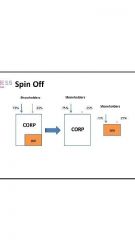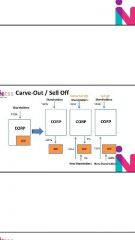![]()
![]()
![]()
Use LEFT and RIGHT arrow keys to navigate between flashcards;
Use UP and DOWN arrow keys to flip the card;
H to show hint;
A reads text to speech;
15 Cards in this Set
- Front
- Back
|
Acquisition or take-over |
transaction aiming at acquire a stockholding or some assets of a target company in exchange of cash or shares |
|
|
Merger |
the combination of two or more companies through which one company absorbs the others or a newly created company absorbs all others |
|
|
M&A |
a strategic action of a company which may include the acquisition, divestment, spin/split-off or merger with the aim to create shareholders value |
|
|
Spin off/split off |

|
|
|
Sell off |

|
|
|
Price to book value |
The price to book value, connect the historical numbers with the future beliefs for a company. The book to value are based on the Balance sheet and the market value based on how the stock values it to. |
|
|
exchange ratios |
Set by free floating system - is not controlling by anyone/anything |
|
|
Premium to book value procedure has many weakness: |
• book value may not even closely resemble a company’s true economic value. • Premiums paid on other company acquisitions have no relation to the rate of return that an acquirer can potentially earn on the investment, and completely ignore risk. |
|
|
Price to earnings per share |
Is the share over or under valued? Different industries has different p/e ratios. You often compare p/e within the same industry. |
|
|
Price to total assets |
• a company uses stockholders and depositors funds to invest in the assets of the company, theoretically, therefore, the assets of the company create value. |
|
|
Discounted cash flow (DCF) |
Discounted cash flow (DCF) is a valuation method used to estimate the value of an investment based on its future cash flows. DCF analysis finds the present value of expected future cash flows using a discount rate. A present value estimate is then used to evaluate a potential investment. |
|
|
Acquisitions and MergersDefence |
• Poison Pills - shareholder right plan. An offering that gives the target shareholders the right to buy shares in either the target or an acquirer at a deeply discounted price. Not so attractive to acquire. • Staggered Board - In many public companies, a board of directors whose three-year terms are staggered so that only one-third of the directors are up for election each year. • White Knight - A target company’s defense against a hostile takeover attempt, in which it looks for another, friendlier company to acquire it• White Squire - A variant of the white knight defense, in which a large, passive investor or firm agrees to purchase a substantial block of shares in a target with special voting rights |
|
|
Place of Taxable Transactions + Exemption |
General rule •Where transport begins•Where Supplier has fixed establishment Exemption •Many services (real estate, entertainment)•Works contracts (registration number)•Imports (country of import)•Intra-community acquisitions (destination generally) |
|
|
Intra-Community Acquisitions |
•General Rule: Supplies exemption, Purchases Taxed, In Destination country • Taxable Persons: Intra-community acquisitions added to sales. But also deducted from purchases•Conditional exemption: Country of origin Small farmers. Exemption: Transport, Ancillary services to transport, Intermediaries in transport•Inclusion: Consumer buying transport |
|
|
Why M&A? |
1. The interaction of several parts of a system which will produce a different effect/an effect bigger than the sum of the individual effects. a. Economies of scale b. Increased market share c. Complementarity (capacity to do “cross-selling”) 2. Improvement of the strategic position a. Geographical diversification b. Increase financial stability and financing capacity c. Brand improvement d. Hiring (take-over of key employees) e. Know-how acquisition |

